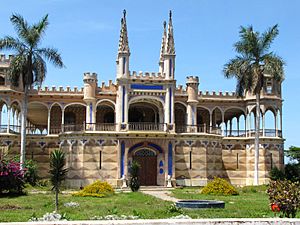San Vicente de Cañete facts for kids
Quick facts for kids
San Vicente de Cañete
|
|||
|---|---|---|---|

Castillo Unanue, one of the main tourist attractions
|
|||
|
|||
| Nickname(s):
Cuna y Capital del Arte Negro Nacional (Cradle and Capital of Afro-Peruvian Art)
|
|||
| Country | |||
| Region | Lima | ||
| Province | Cañete | ||
| District | San Vicente de Cañete | ||
| Established | 30 August 1556 | ||
| Elevation | 40 m (130 ft) | ||
| Population | |||
| • Estimate
(2015)
|
85,533 | ||
| Demonym(s) | sanvicentino(a) | ||
| Website | municanete.gob.pe | ||
San Vicente de Cañete, often called San Vicente or just Cañete, is a city in southern Lima Region, Peru. It is the capital of the Cañete Province. In 2015, about 85,533 people lived there.
Cañete is known for being a warm and peaceful place. It is also famous as the "Cradle and Capital of Afro-Peruvian Art." This means it's a very important place for the culture and art of people with African heritage in Peru.
Contents
Where is Cañete Located?
Cañete is about 144 kilometers (90 miles) south of Lima, the capital of Peru. It takes about one and a half hours to drive there. Many tourists use Cañete as a starting point to visit the Lunahuaná District, which is known for adventure sports and vineyards.
The main square, called Plaza de Armas, is a few blocks from the Pan-American Highway. This highway is a major road that connects many countries in the Americas. All buses traveling south from Lima or north to Lima on this highway pass through Cañete.
A district called Cerro Azul, Peru is located north of San Vicente de Cañete city center.
A Look into Cañete's History
The first people to live in this area were called the Huarcos. Later, many people from Africa were brought to the Peruvian coast between the 1600s and 1700s. They were forced to work on large farms growing cotton, sugar cane, and grapes for wine.
These people and their families settled in Cañete. They came from places like Guinea, the Congo, and Angola. Their traditions and culture have greatly shaped Cañete, making it a special place for Afro-Peruvian art and music.
Fun Things to Do in Cañete
Cañete offers a mix of history and modern fun. The Castillo Unanue, shown in the picture, is an old castle and a popular place to visit. It gives you a glimpse into the past.
Cañete also has a district called Asia. This area is famous for its many beaches. People from Lima often rent houses there to enjoy the sun and sand. Asia also has a large shopping center called Sur Plaza Boulevard, where you can find shops and restaurants.
Cañete is also known for producing Pisco, a famous Peruvian drink. It's an important part of the local culture and economy.
Images for kids
See also
 In Spanish: San Vicente de Cañete para niños
In Spanish: San Vicente de Cañete para niños







